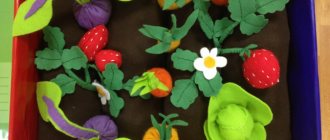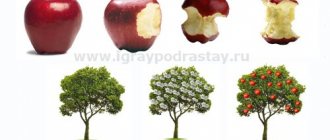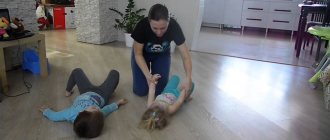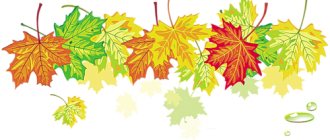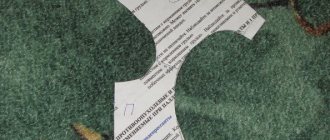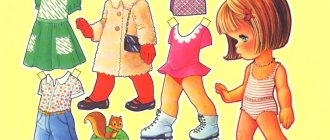Didactic game for the younger group “What grows where?”
ZOYA KHANINA
Didactic game for the younger group “What grows where?”
Didactic game for the younger group on the topic : “What grows ?
" Goal: expand and clarify ideas
children about vegetables and fruits, develop memory and speech.
- consider vegetables and fruits;
-explain how all this can be called in one word or
-pay attention to the following signs
vegetables and fruits: color, shape, taste;
-tell and show children where vegetables and fruits grow ;
- invite children to tell from their own experience what can be cooked from vegetables and fruits;
-learn appropriate riddles with the children: for example: They hang in clusters
And they look at the sun,
Color like a traffic light
Red Yellow. (tomato)
.
Material: model of a tree, model of a vegetable garden, drawn and cut out vegetables and fruits.
Didactic game "Cat's House". “Cat’s Garden” (for children of the first junior group) The purpose of the game: to give children a basic understanding of the vegetable garden and orchard, about what grows in them. Objectives: develop the ability to distinguish.
Homework for children of the secondary speech therapy group on the lexical topic “Autumn Gifts” Topic: Autumn Gifts Paste (draw) pictures depicting vegetables and fruits. The child must be able to name: • Fruits • Vegetables • In one word:.
Source
Didactic game “Where does it grow?”
Svetlana Terekhova
Didactic game “Where does it grow?”
Target. To consolidate children's knowledge on the topic "Fruits and vegetables."
Tasks.
• Consolidate and clarify children's knowledge about vegetables and fruits.
• Strengthen the ability to distinguish between vegetables and fruits.
• Activate children's knowledge about where fruits and vegetables grow and their beneficial properties.
• Develop memory, thinking, attention, oral speech.
• Clarify the idea of the benefits of fruits for human health.
• Foster a caring attitude towards nature.
• Cultivate diligence when completing tasks.
Material: pictures of vegetables and fruits, baskets.
Preliminary work: reading fiction on the topic, observing nature, guessing riddles about vegetables and fruits, didactic games on the topic.
Form of organization of work with children: individual or subgroup.
Vegetables, fruits and two baskets are on the table.
Educator. Name what's on the table
Child. Lists vegetables and fruits.
Educator. How can you call cabbage, cucumber, etc. in one word?
Educator. Where do vegetables grow?
Child. In a garden bed.
Educator. Where do fruits grow?
Child. On a tree in the garden.
Educator. How are they useful for humans?
Child. They contain a lot of vitamins, and they are good for human health.
Educator. There are two baskets in front of you, what is the picture on them?
Child. On one picture there is a tree, and on the other there are beds.
Educator. What do you think, which basket should be used to collect vegetables and which should be fruits?
Child. Vegetables should be collected in a basket with a pattern of a garden bed, and fruits should be collected with a pattern of a tree.
Educator. Why do you think so?
Child. There are beds in the garden and vegetables grow there, trees and shrubs in the garden and fruits grow on them.
Educator. Well done. Now put the fruits and vegetables in the baskets.
Note. There are times when a child cannot cope with the game or finds it difficult. A detailed verbal description of objects and their location, which needs to be remembered and reproduced, will help with this. At first, this whole procedure is performed out loud together with the teacher, after a while the child completes this task independently.
Option 2.
You can arrange a competition between children “Who can collect their basket faster?”
Multifunctional didactic game “Who lives where, what grows where” No one will deny the urgent need for didactic games when working with children. A child learns about the world through play, and, of course, it’s a good one. Didactic game “What grows where?” With the onset of summer, our kindergarten began planting a vegetable garden. Each group planted and tended their own territory. Plantings took place. Didactic game for children 5–7 years old “What grows where?” Did. task: to clarify children’s knowledge of the names and places where plants grow; develop attention, intelligence, memory. Materials:.
Didactic game in the senior group “What? Where? When?" on the topic “Autumn” • To consolidate children’s knowledge about the characteristic signs of autumn. • Cultivate perseverance and a sense of teamwork. On the way to kindergarten I met.
Game with clothespins “What grows where. Who lives where" Didactic game "What grows where. Who lives where". You can play this game at both junior and senior preschool age. Develops fine.
Summary of GCD for FEMP “What grows and where” in the preparatory school group. Summary of GCD for FEMP in the preparatory group for school. Topic: “What grows where” Objectives: • To consolidate ideas about plants in the garden and vegetable garden.
Summary of the trial didactic game “What grows where?” Group: 1st junior Goal: expand and clarify children’s ideas about vegetables and fruits. Objectives: Educational: to develop interest in children.
Visual and didactic game “What grows where” ABSTRACT Visual and didactic aid: the didactic game “What grows where” is intended for young and middle-aged children 4-5. DIY educational board “What grows where?” I present to you a master class: “Making a didactic game: “What grows where?” This material will help educators and additional teachers.
Source
Working with children in a group. No. 1. Didactic game “What grows where?”
Activities
No. 1. Didactic game “What grows where?”
Tasks. Consolidating children's knowledge about plants, developing the ability to establish spatial connections between objects.
No. 2. Conversation on the topic “Livestock breeders”.
Tasks. Introduce children to the group of agricultural professions united by this concept, talk about the work of livestock breeders. introduce the names of various professions, teach children to form the appropriate names.
No. 3. Work in the sensory education corner.
Tasks. Teach children to examine objects, identify their properties, including different senses, and talk about their impressions.
No. 4. Playing with singing A. Filippenko’s song “Frogs”.
Tasks. To form a stable interest in music, emotional responsiveness. Teach children to perform movements in accordance with the lyrics of the song.
No. 5. Familiarization with fiction: memorizing M. Isakovsky’s poem “Go beyond the seas and oceans.”
Tasks. To develop in children the ability to recite a poem: correctly place semantic accents, use various means of voice expressiveness (timbre, dynamics, pitch, duration).
Day 9
Morning
Activities
No. 1. Duty in a corner of nature; conversation on the topic “Flower Island”.
Tasks. Organize the updating and generalization of children’s knowledge necessary for the growth of plants, including loosening the soil. Teach children to identify plants in which it is necessary to loosen the soil and independently determine the need for loosening.
No. 2. Conversation on the topic “The street where you live.”
Tasks. To arouse in children a desire to learn about the history of the streets on which they live, to develop information competencies (learn to work with various sources of information, search and select the necessary information).
No. 3. Outdoor game “Quickly to the house.”
Tasks. Exercise children in running, develop the ability to coordinate their actions with a sound signal. Develop the functional capabilities of the body, attention.
No. 4. Didactic game “When does this happen?”
Tasks. Teach children to use knowledge about the parts of the day and their sequence, the ability to compare what is shown in the picture with a certain part of the day to solve a game problem in everyday life. Develop visual perception, attention, coherent speech.
No. 5. Role-playing game “Bus”: the plot “A trip to the zoo.”
Tasks. Teach children to agree on a sequence of joint actions, distribute roles, and carry out their plans together. Encourage children to use familiar songs and poems in play, and to include basic concepts of the topic in role-playing dialogues.
No. 6. Sound culture of speech: exercise “What do you hear?”
Tasks. Teach children to distinguish by ear the sound of objects when performing actions with them (pouring water, cutting paper with scissors, etc.), to select a name for these sounds. Develop auditory perception, verbal imagination, introduce the rules of word formation.
No. 7. Introduction to fine art: viewing a painting about the profession of a sculptor from the series “Who should I be?”
Tasks. To update and supplement children’s knowledge about the profession of a sculptor, his tools, their use, and main types of activities
sculptor. Invite children to try themselves as a sculptor when working with plasticine, clay, and snow.
Didactic game for children of the first junior group “What grows where”
Didactic game for the first junior group.
"What grows "
Didactic task . To train children in the ability to combine objects: where, what grows , to consolidate knowledge about vegetables, fruits and flowers.
Game rule. Cover the cells only with those cards that correspond to the content of the large card; small cards with vegetables - vegetable garden, cards with fruits - garden, cards with flowers - flower bed.
Game task. Show Dunno where vegetables , fruits, and flowers grow. Find small cards with images of vegetables, fruits, flowers and close the cells on large cards where a vegetable garden, a garden and a flower bed are drawn.
Progress of the game. The teacher lays out three cards on the table, where a vegetable garden, a garden, and a flower bed are drawn with empty cells next to them. Small cards are mixed up next to large cards.
Educator: guys, look who came to us! (shows the Dunno doll)
This Dunno doll, can you imagine guys, he doesn’t know where
vegetables , fruits, and flowers grow. Let's help him, put the small cards correctly in our cells; where, what should grow .
Let's take a hedgehog to help, he will watch whether you are laying out the cards correctly. If the hedgehog snorts angrily, it means you made a mistake. The teacher calls the name of the child whose name she named, comes up, takes a small card, says what it is (vegetable, fruit, flower, and puts it on the card where it grows .
The game continues until all the cards are correctly laid out.
Didactic games aimed at developing the ability to generalize, compare, identify signs, generalize, classify 1 block: Didactic games aimed at developing the ability to identify the essential characteristics of objects 1. Didactic game “For what.”
Long-term planning of educational activities with young children in the educational area “Cognition” (section “Sensory development”) September 1 week Colored water. Main didactic task: Introducing color. Week 2 Colored cubes. The main didactic task:.
Source
Didactic games on ecology for preschoolers. Middle - senior group
Didactic games on ecology
1. “Birds, fish, animals” Purpose: To train children in the ability to name an object of a certain group of objects. Game actions: The presenter throws the ball to the child and says the word “birds”. The child who catches the ball must select a specific concept, for example, “sparrow,” and throw the ball back. The next child must name the bird, but not repeat himself. The game is played in a similar way with the words “animals” and “fish”. 2. “Guess what’s in your hand” Goal: Distinguish vegetables, fruits and berries by touch. Game actions: Children stand in a circle, holding their hands behind their backs. The teacher places models of vegetables, berries and fruits in the children’s hands. Children must guess. The teacher shows, for example, a pear and asks to determine who has the same object (fruit, vegetable, berry). 3. “Flies, swims, runs” Purpose: Depict the method of movement of an object. Game actions: The presenter names or shows the children an object of living nature and invites the children to depict the method of movement of this object. For example, when hearing the word “bear,” children begin to imitate walking like a bear; “magpie” children begin to wave their arms and so on. 4. Game “Good - Bad” Purpose: To improve children’s knowledge about the phenomena of living and inanimate nature, animals and plants. Game actions: The teacher or teacher offers children different situations, and the children make conclusions, for example: “Is a clear sunny day in the fall good or bad?”, “All the wolves have disappeared in the forest - is this good or bad?”, “It rains every day - is it bad or good?”, “A snowy winter - is it good or bad?”, “All the trees are green - is it good or bad?”, “A lot of flowers in our garden - is it bad or good?”, “My grandmother in the village has is a cow good or bad?”, “All the birds on earth have disappeared - is that good or bad?” and so on. 5. “Who is after whom?” Goal: Show children that in nature everything is connected. Continue to instill in children a caring attitude towards all animals. Game actions: The teacher invites the called child to connect with a ribbon all the animals that hunt each other. Other children also help find the correct pictures of animals. You can suggest starting the game with a plant, a frog or a mosquito. 6. “What's extra” Usually this game is used to develop thinking, but it can also be used to develop visual and auditory memory, depending on how the material is presented - visually or auditorily. Goal: development of visual and auditory memory and thinking, activation of children's vocabulary. Equipment: cards with a set of 4 words (pictures): three words - one generalizing concept, one word - another generalizing concept. Progress of the game: The child is asked to listen (watch) and remember a number of words (pictures). The presentation time for each picture is 1 second. After presentation, the pictures are covered or removed. Then he is asked to repeat these words (name the pictures). Next, the child is asked the question: “What word (picture) do you think is superfluous? Why?". Then the child is asked to remember and list the remaining three words (pictures). After this, the child is once again asked to list the entire series of words (pictures) in the order in which they were presented. The complexity of the game occurs due to an increase in the number of memorized words or pictures, as well as through a more subtle differentiation of general concepts (for example, tableware - tableware, kitchen, tea). Approximate list of equipment for the game Domestic - wild birds Chicken, goose, turkey ram Duck, rooster, peacock horse Chicken, duckling, gosling pig Birds - animals Ostrich, penguin, stork dolphin Dolphin, walrus, octopus penguin 7. “The Fourth Wheel” Purpose: . develop in children a cognitive interest in the life of feathered friends, teach them to understand the figurative meaning of riddles. 1. hare, hedgehog, fox, bumblebee; 2. wagtail, spider, starling, magpie; 3. butterfly, dragonfly, raccoon, bee; 4. grasshopper, ladybug, sparrow, chafer; 5. bee, dragonfly, raccoon, bee; 6. grasshopper, ladybug, sparrow, mosquito; 7. cockroach, fly, bee, cockchafer; 8. dragonfly, grasshopper, bee, ladybug; 9. frog, mosquito, beetle, butterfly; 10. dragonfly, moth, bumblebee, sparrow. 8. “Lay out a bird (animal, object) from geometric shapes” Goal: continue to teach children to lay out images of animals, objects, natural phenomena, etc. d., using geometric shapes; develop creative imagination, evoke a desire to fantasize. Equipment: cards, a set of geometric shapes. The teacher offers to play a game during which children come up with their own objects and images, using previously acquired knowledge and skills. 9. Find by description Purpose: to consolidate the idea of the features of the appearance of plants, to teach children to independently describe a plant. Game task: find a plant based on the listed characteristics. Material: cards with pictures of plants. Progress of the game: The presenter names the characteristic features of a particular plant without naming it. Children look for his image among the cards. The winner is the one who quickly and correctly finds or names the answer. 10. Lotto “What grows where?” Goal: to strengthen children’s ability to classify plants according to their place of growth; develop mindfulness. Game task: fill the playing field. Materials: playing fields - meadow, forest, pond, swamp. Cards depicting plants growing in these ecosystems. Progress of the game: Children choose playing fields. The presenter shuffles the cards and, taking out one at a time, names the plant. Children playing take away those cards that correspond to their playing field. The one who fills the playing field faster wins.
We recommend watching:
Ecological holiday. Earth Day. Scenario for children of the senior group Didactic games on ecology for children of the preparatory group of kindergarten Ecological game: “What? Where? When?" for children 5-7 years old Game activities on ecology in kindergarten. Junior group
Similar articles:
Ecological games for schoolchildren
Ecological holiday for schoolchildren. Scenario 7-9 grade
